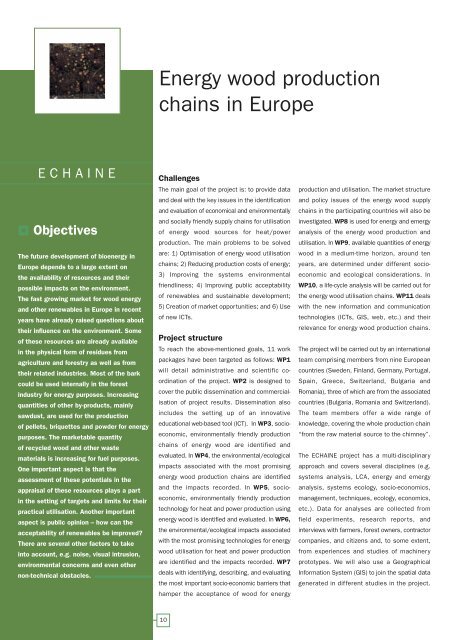European Bio-Energy Projects
European Bio-Energy Projects
European Bio-Energy Projects
You also want an ePaper? Increase the reach of your titles
YUMPU automatically turns print PDFs into web optimized ePapers that Google loves.
ECHAINE Challenges<br />
Objectives<br />
The future development of bioenergy in<br />
Europe depends to a large extent on<br />
the availability of resources and their<br />
possible impacts on the environment.<br />
The fast growing market for wood energy<br />
and other renewables in Europe in recent<br />
years have already raised questions about<br />
their influence on the environment. Some<br />
of these resources are already available<br />
in the physical form of residues from<br />
agriculture and forestry as well as from<br />
their related industries. Most of the bark<br />
could be used internally in the forest<br />
industry for energy purposes. Increasing<br />
quantities of other by-products, mainly<br />
sawdust, are used for the production<br />
of pellets, briquettes and powder for energy<br />
purposes. The marketable quantity<br />
of recycled wood and other waste<br />
materials is increasing for fuel purposes.<br />
One important aspect is that the<br />
assessment of these potentials in the<br />
appraisal of these resources plays a part<br />
in the setting of targets and limits for their<br />
practical utilisation. Another important<br />
aspect is public opinion – how can the<br />
acceptability of renewables be improved?<br />
There are several other factors to take<br />
into account, e.g. noise, visual intrusion,<br />
environmental concerns and even other<br />
non-technical obstacles.<br />
<strong>Energy</strong> wood production<br />
chains in Europe<br />
The main goal of the project is: to provide data<br />
and deal with the key issues in the identification<br />
and evaluation of economical and environmentally<br />
and socially friendly supply chains for utilisation<br />
of energy wood sources for heat/power<br />
production. The main problems to be solved<br />
are: 1) Optimisation of energy wood utilisation<br />
chains; 2) Reducing production costs of energy;<br />
3) Improving the systems environmental<br />
friendliness; 4) Improving public acceptability<br />
of renewables and sustainable development;<br />
5) Creation of market opportunities; and 6) Use<br />
of new ICTs.<br />
Project structure<br />
To reach the above-mentioned goals, 11 work<br />
packages have been targeted as follows: WP1<br />
will detail administrative and scientific coordination<br />
of the project. WP2 is designed to<br />
cover the public dissemination and commercialisation<br />
of project results. Dissemination also<br />
includes the setting up of an innovative<br />
educational web-based tool (ICT). In WP3, socioeconomic,<br />
environmentally friendly production<br />
chains of energy wood are identified and<br />
evaluated. In WP4, the environmental/ecological<br />
impacts associated with the most promising<br />
energy wood production chains are identified<br />
and the impacts recorded. In WP5, socioeconomic,<br />
environmentally friendly production<br />
technology for heat and power production using<br />
energy wood is identified and evaluated. In WP6,<br />
the environmental/ecological impacts associated<br />
with the most promising technologies for energy<br />
wood utilisation for heat and power production<br />
are identified and the impacts recorded. WP7<br />
deals with identifying, describing, and evaluating<br />
the most important socio-economic barriers that<br />
hamper the acceptance of wood for energy<br />
10<br />
production and utilisation. The market structure<br />
and policy issues of the energy wood supply<br />
chains in the participating countries will also be<br />
investigated. WP8 is used for energy and emergy<br />
analysis of the energy wood production and<br />
utilisation. In WP9, available quantities of energy<br />
wood in a medium-time horizon, around ten<br />
years, are determined under different socioeconomic<br />
and ecological considerations. In<br />
WP10, a life-cycle analysis will be carried out for<br />
the energy wood utilisation chains. WP11 deals<br />
with the new information and communication<br />
technologies (ICTs, GIS, web, etc.) and their<br />
relevance for energy wood production chains.<br />
The project will be carried out by an international<br />
team comprising members from nine <strong>European</strong><br />
countries (Sweden, Finland, Germany, Portugal,<br />
Spain, Greece, Switzerland, Bulgaria and<br />
Romania), three of which are from the associated<br />
countries (Bulgaria, Romania and Switzerland).<br />
The team members offer a wide range of<br />
knowledge, covering the whole production chain<br />
“from the raw material source to the chimney”.<br />
The ECHAINE project has a multi-disciplinary<br />
approach and covers several disciplines (e.g.<br />
systems analysis, LCA, energy and emergy<br />
analysis, systems ecology, socio-economics,<br />
management, techniques, ecology, economics,<br />
etc.). Data for analyses are collected from<br />
field experiments, research reports, and<br />
interviews with farmers, forest owners, contractor<br />
companies, and citizens and, to some extent,<br />
from experiences and studies of machinery<br />
prototypes. We will also use a Geographical<br />
Information System (GIS) to join the spatial data<br />
generated in different studies in the project.

















